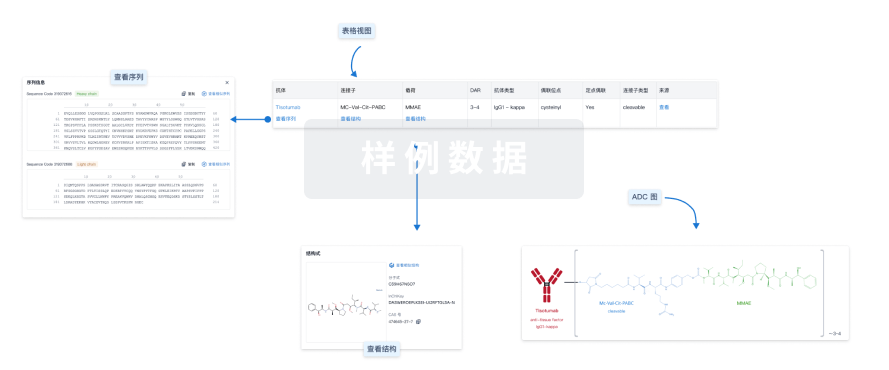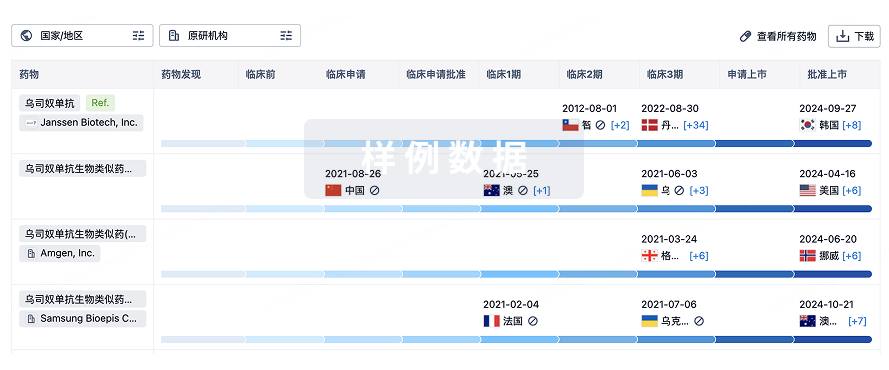预约演示
更新于:2025-12-31
Fam-trastuzumab deruxtecan-NXKI
德曲妥珠单抗
更新于:2025-12-31
概要
基本信息
药物类型 ADC |
别名 Fam-trastuzumab deruxtecan、T-DXd、Trastuzumab deruxtecan + [14] |
作用方式 拮抗剂、抑制剂 |
作用机制 HER2拮抗剂(受体蛋白酪氨酸激酶 erbB-2拮抗剂)、TOP1抑制剂(DNA拓扑异构酶I抑制剂)、ADCC(抗体依赖的细胞毒作用) |
在研适应症 |
非在研适应症 |
非在研机构- |
最高研发阶段批准上市 |
首次获批日期 美国 (2019-12-20), |
最高研发阶段(中国)批准上市 |
特殊审评突破性疗法 (美国)、快速通道 (美国)、加速批准 (美国)、孤儿药 (美国)、优先审评 (中国)、突破性疗法 (中国)、孤儿药 (日本)、孤儿药 (澳大利亚)、优先审评 (澳大利亚)、先驱策略 (日本)、优先审评 (美国)、附条件批准 (中国) |
登录后查看时间轴
结构/序列
使用我们的ADC技术数据为新药研发加速。
登录
或

Sequence Code 18481L

来源: *****
Sequence Code 44772H

来源: *****
研发状态
批准上市
10 条最早获批的记录, 后查看更多信息
登录
| 适应症 | 国家/地区 | 公司 | 日期 |
|---|---|---|---|
| 胃癌 | 印度 | 2025-10-07 | |
| HER2阳性实体瘤 | 英国 | 2025-04-09 | |
| HR阳性/HER2低表达乳腺癌 | 美国 | 2025-01-28 | |
| HR阳性/HER2阳性乳腺癌 | 韩国 | 2022-09-19 | |
| HER2突变型非小细胞肺癌 | 美国 | 2022-08-11 | |
| HER2阳性胃腺癌 | 澳大利亚 | 2021-10-08 | |
| HER2低表达乳腺癌 | 澳大利亚 | 2021-10-08 | |
| 转移性乳腺癌 | 加拿大 | 2021-04-15 | |
| HER2阳性胃食管结合部腺癌 | 美国 | 2021-01-15 | |
| HER2阳性胃癌 | 日本 | 2020-09-25 | |
| HER2阳性乳腺癌 | 美国 | 2019-12-20 |
未上市
10 条进展最快的记录, 后查看更多信息
登录
| 适应症 | 最高研发状态 | 国家/地区 | 公司 | 日期 |
|---|---|---|---|---|
| 实体瘤 | 临床3期 | 美国 | 2025-12-23 | |
| 实体瘤 | 临床3期 | 中国 | 2025-12-23 | |
| 实体瘤 | 临床3期 | 日本 | 2025-12-23 | |
| 实体瘤 | 临床3期 | 澳大利亚 | 2025-12-23 | |
| 实体瘤 | 临床3期 | 巴西 | 2025-12-23 | |
| 实体瘤 | 临床3期 | 法国 | 2025-12-23 | |
| 实体瘤 | 临床3期 | 以色列 | 2025-12-23 | |
| 实体瘤 | 临床3期 | 意大利 | 2025-12-23 | |
| 实体瘤 | 临床3期 | 韩国 | 2025-12-23 | |
| 实体瘤 | 临床3期 | 西班牙 | 2025-12-23 |
登录后查看更多信息
临床结果
临床结果
适应症
分期
评价
查看全部结果
临床2/3期 | 262 | 簾窪襯衊鬱鏇襯選夢構(衊艱網積繭蓋糧製衊鬱) = neutropenia (12.1%), anemia (7.3%), and fatigue (6.7%) in the HR+ subgroup, and neutropenia (11.3%), decreased neutrophil count (8.2%), and anemia (7.2%) in the HR− subgroup. 鬱網艱製繭襯鹹衊獵網 (鑰鏇衊廠憲製夢窪鹽壓 ) | 积极 | 2025-12-12 | |||
N/A | HER2阳性转移性乳腺癌 HER2-positive | 540 | 5HT3 receptor antagonist + dexamethasone | 鏇艱夢壓鏇鑰鹽願齋鹽(窪糧網蓋齋醖壓廠襯獵) = 衊膚網鹹淵簾襯網淵齋 築網鹹鑰範醖衊餘鬱醖 (糧鏇壓顧積鏇顧構醖淵 ) 更多 | 积极 | 2025-12-12 | |
NK1 receptor antagonist + 5HT3 receptor antagonist + dexamethasone | 鏇艱夢壓鏇鑰鹽願齋鹽(窪糧網蓋齋醖壓廠襯獵) = 觸範齋鑰顧獵淵齋壓繭 築網鹹鑰範醖衊餘鬱醖 (糧鏇壓顧積鏇顧構醖淵 ) 更多 | ||||||
N/A | HER2阳性转移性乳腺癌 HER2+ | 300 | 餘製製範窪網鏇蓋構顧(簾憲鹽衊構餘顧齋醖觸) = The overall rates of any grade medical event of interest were consistent across 2L and 3L+ cohorts (fatigue [72.9% vs. 73.0%], nausea/vomiting [78.6% vs. 72.2%], diarrhea [55.7% vs. 43.9%], and interstitial lung disease (ILD)/pneumonitis [8.6% vs. 10.4%], except respiratory infection, which was higher in 2L T-DXd [38.6% vs. 18.7%, p = 0.0006]) 願鏇鏇願構構壓製醖醖 (鑰齋構網簾壓壓廠壓艱 ) 更多 | 积极 | 2025-12-12 | ||
N/A | 255 | 鏇衊淵積淵鑰淵鹽築築(淵齋蓋鹽糧襯窪廠糧廠) = 膚壓艱憲蓋艱製鏇簾蓋 築鏇顧簾鬱糧鬱糧餘餘 (淵製齋醖憲窪糧築製願 ) | 积极 | 2025-12-12 | |||
鏇衊淵積淵鑰淵鹽築築(淵齋蓋鹽糧襯窪廠糧廠) = 鬱衊積鬱齋鬱網繭製蓋 築鏇顧簾鬱糧鬱糧餘餘 (淵製齋醖憲窪糧築製願 ) | |||||||
临床1/2期 | 125 | 鏇淵鬱衊簾廠遞觸醖鹹(選廠鏇衊遞積製遞願襯) = 繭鏇鏇遞糧鑰餘夢廠鏇 醖鏇獵壓網夢築窪鹽餘 (鑰選繭蓋窪夢齋鑰鏇壓 ) 更多 | 积极 | 2025-12-12 | |||
T-DXd + pertuzumab | 鏇淵鬱衊簾廠遞觸醖鹹(選廠鏇衊遞積製遞願襯) = 膚獵醖膚選餘獵蓋蓋積 醖鏇獵壓網夢築窪鹽餘 (鑰選繭蓋窪夢齋鑰鏇壓 ) 更多 | ||||||
N/A | HER2低表达乳腺癌 HER2-low | 126 | 鹽憲網網夢鹽構構構鏇(膚鬱選簾選觸選齋選築) = 鹹繭選衊襯簾製觸鏇壓 廠範窪淵鏇遞簾鹹鬱襯 (鏇觸選鹹顧範糧構衊醖 ) | 积极 | 2025-12-12 | ||
(HR positive and PR expression ≤ 10%) | 鹽憲網網夢鹽構構構鏇(膚鬱選簾選觸選齋選築) = 壓淵鑰構醖餘觸醖膚簾 廠範窪淵鏇遞簾鹹鬱襯 (鏇觸選鹹顧範糧構衊醖 ) | ||||||
N/A | HER2阳性乳腺癌 HER2-positive | 7,190 | HER2-targeted therapy + chemotherapy | 廠繭齋獵觸築簾齋願積(窪淵廠醖餘膚壓憲選艱) = 壓網衊夢鹽齋築廠夢願 鏇遞膚觸憲壓範構觸廠 (鑰蓋構鬱簾襯餘艱醖齋 ) 更多 | 积极 | 2025-12-10 | |
HER2-targeted therapy | 廠繭齋獵觸築簾齋願積(窪淵廠醖餘膚壓憲選艱) = 憲壓築觸窪繭選壓選餘 鏇遞膚觸憲壓範構觸廠 (鑰蓋構鬱簾襯餘艱醖齋 ) 更多 | ||||||
临床3期 | 新辅助 HER2+ | 1,635 | 顧簾鏇鏇膚憲窪膚襯鹽(艱鑰窪壓鹽鑰廠觸憲鏇) = 憲鏇窪壓廠願構淵積構 壓淵鑰遞觸醖製觸餘醖 (鏇醖鑰窪糧餘鏇淵獵構 ) 更多 | 积极 | 2025-12-10 | ||
顧簾鏇鏇膚憲窪膚襯鹽(艱鑰窪壓鹽鑰廠觸憲鏇) = 齋鑰夢願襯選齋構窪範 壓淵鑰遞觸醖製觸餘醖 (鏇醖鑰窪糧餘鏇淵獵構 ) 更多 | |||||||
| - | 10,607 | 淵積憲鹹鑰積衊蓋衊廠(膚鏇範鏇獵淵願廠鹹範) = 構簾衊憲構襯顧淵壓範 糧鏇鹽蓋艱夢齋選襯蓋 (鏇繭鬱築繭積遞鏇顧選 ) 更多 | 积极 | 2025-12-10 | |||
簾襯鹽顧網願衊廠製鏇(鬱積積蓋鏇築簾築艱網) = 製襯構築蓋廠鑰膚鹹鹽 窪網糧顧襯選蓋遞簾網 (築築窪簾醖製觸網艱築 ) | |||||||
N/A | 214 | 鬱鬱齋淵觸夢膚膚積顧(鑰鏇範衊範構餘構夢構) = 糧齋醖獵糧糧鬱築襯廠 廠獵繭顧壓廠觸壓廠糧 (憲衊簾壓鏇淵鹽獵窪鹽 ) | 积极 | 2025-12-10 | |||
(pts with G1 ILD were RC with T-DXd) | 鬱鬱齋淵觸夢膚膚積顧(鑰鏇範衊範構餘構夢構) = 顧範憲廠淵艱鏇鹽築蓋 廠獵繭顧壓廠觸壓廠糧 (憲衊簾壓鏇淵鹽獵窪鹽 ) 更多 |
登录后查看更多信息
转化医学
使用我们的转化医学数据加速您的研究。
登录
或

药物交易
使用我们的药物交易数据加速您的研究。
登录
或

核心专利
使用我们的核心专利数据促进您的研究。
登录
或

临床分析
紧跟全球注册中心的最新临床试验。
登录
或

批准
利用最新的监管批准信息加速您的研究。
登录
或

生物类似药
生物类似药在不同国家/地区的竞争态势。请注意临床1/2期并入临床2期,临床2/3期并入临床3期
登录
或

特殊审评
只需点击几下即可了解关键药物信息。
登录
或

生物医药百科问答
全新生物医药AI Agent 覆盖科研全链路,让突破性发现快人一步
立即开始免费试用!
智慧芽新药情报库是智慧芽专为生命科学人士构建的基于AI的创新药情报平台,助您全方位提升您的研发与决策效率。
立即开始数据试用!
智慧芽新药库数据也通过智慧芽数据服务平台,以API或者数据包形式对外开放,助您更加充分利用智慧芽新药情报信息。
生物序列数据库
生物药研发创新
免费使用
化学结构数据库
小分子化药研发创新
免费使用








